
How Often Should You Update Your Website Content?
If you’re wondering how often you should update your website content, you’re not alone. Keeping your content fresh isn’t just a nice-to-have. It’s key if you seek to stay visible on search engines, build trust with visitors, and drive consistent traffic.
Outdated pages can lose rankings. You can also miss conversions. Plus, outdated content will send the wrong message to users. So, in this guide, you will learn a few things. First, why content updates matter, and how often to refresh different types of pages. Then we will explore how to spot aging content and how to build a smart update schedule. If you run a blog, a store, or a service site, content maintenance will ensure how to keep your website remains fresh. And this guide is here to help you.
How Often Different Types of Content Should Be Updated
First of all, let’s make one thing clear – not all content needs to be updated at the same time. The correct update schedule depends on a few factors. Some of them are: what the content is, what it’s meant to do, and how often your audience expects fresh information. Here’s a breakdown of how often different types of content should be updated, and why it matters for traffic, SEO, and conversions.
Blog Posts - Every 3-6 Months
Blog posts often get outdated. Especially if they include stats, trends, or SEO data. That said, updating top-performing blog posts every few months helps maintain rankings, target new search terms, and reflect current user intent. Add new examples, improve visuals, and tighten your intro and CTA.
Product Pages - Quarterly or As Needed
For e-commerce or SaaS, product details can change fast. You must keep product pages updated with the latest features, pricing, FAQs, and images. Even some small changes, like new benefits or testimonials, can boost conversions. Also, help with SEO content maintenance. For more information, hit here to learn more about what SEO strategy and content synergy entail.
Landing Pages - Every 6-12 Months
Landing pages should stay aligned with your current offers and audience expectations. In this case, you should refresh the design, update CTAs, and test copy every 6-12 months. If conversions dip, it’s a clear sign that an update is due.
Evergreen Content - Review Annually
Evergreen posts like guides, definitions, and tutorials may stay relevant for years, but that doesn’t mean you can ignore them. You should check in once a year to update links, optimize keywords, and ensure the content still matches search intent.
Seasonal or Time-Sensitive Pages - Annually or Per Campaign
Things like holiday guides, event landing pages, or yearly roundups should be updated before each season or launch. Outdated seasonal content can confuse users and hurt credibility.
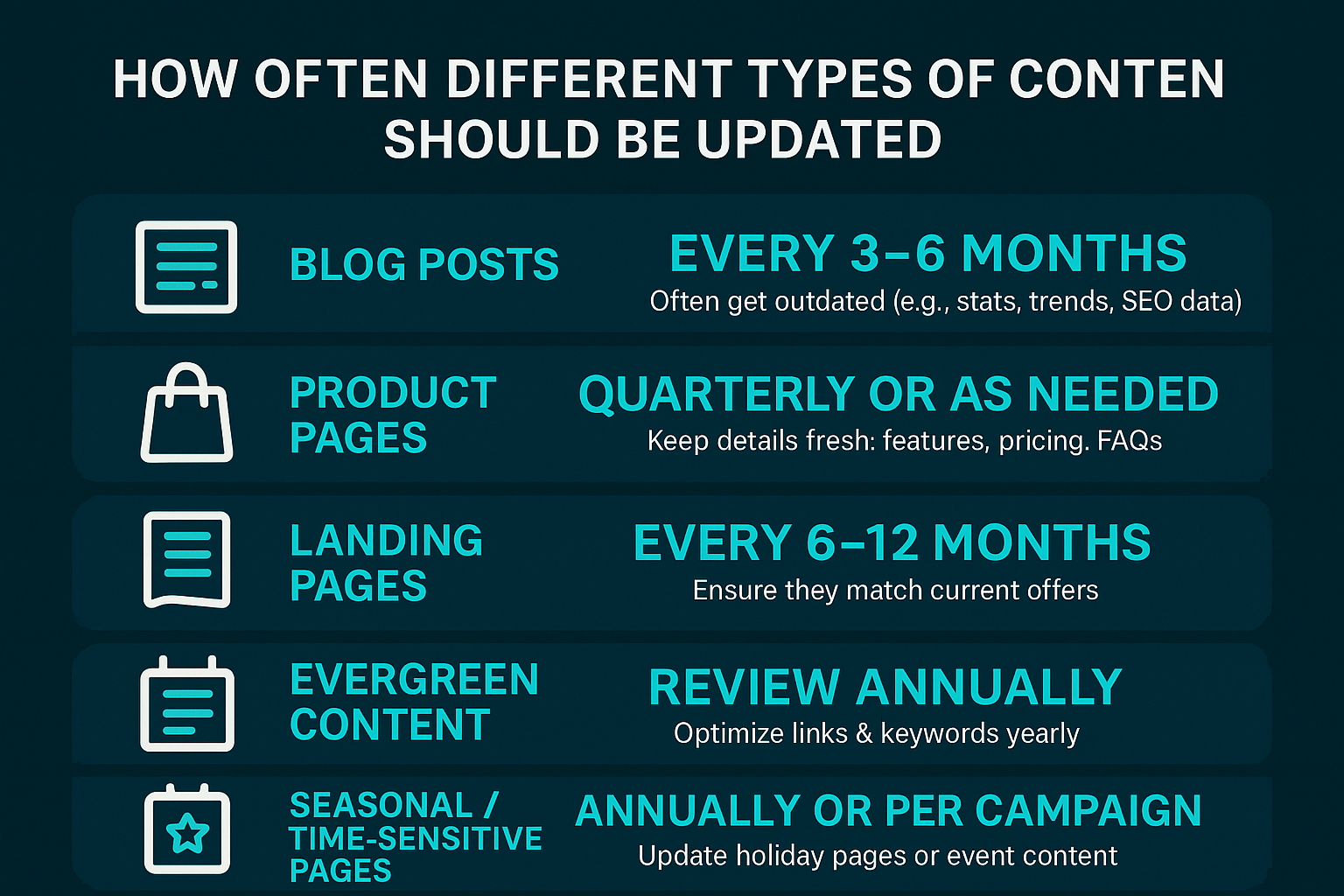
Signs Your Content Needs Updating
Not sure when to update a page? Your website will usually give you hints. Of course, if you know where to look. Here are the top signals that will tell your content needs updating. Especially if you want to stay competitive in search and keep users engaged.
Drop in Traffic or Rankings
If your content used to bring in steady traffic but now it’s slowing down, you might be dealing with content decay. Google favors fresh, relevant pages. When better, newer content appears in the search results, your old page can lose its spot.
Outdated Stats, Dates, or Tools
If your content mentions “trends for 2022,” old pricing, or tools that no longer exist, it’s time for a refresh. Stale info hurts your credibility and turns users away fast.
Broken Links or Missing Media
Dead outbound links, removed images, or broken embeds ruin the user experience. These issues are easy to miss but can increase your bounce rate and lower SEO quality.
Search Intent Has Shifted
Sometimes your topic is still relevant, but what users expect has changed. Check if the top-ranking pages now cover a different angle, format, or keyword focus.
High Bounce or Low Time on Page
If users land on the page and leave quickly, they’re likely not finding what they came for. That’s a strong signal that your content isn’t meeting their needs anymore.
Regularly watching for these signs helps you catch weak points early and turn outdated pages into high performers again.
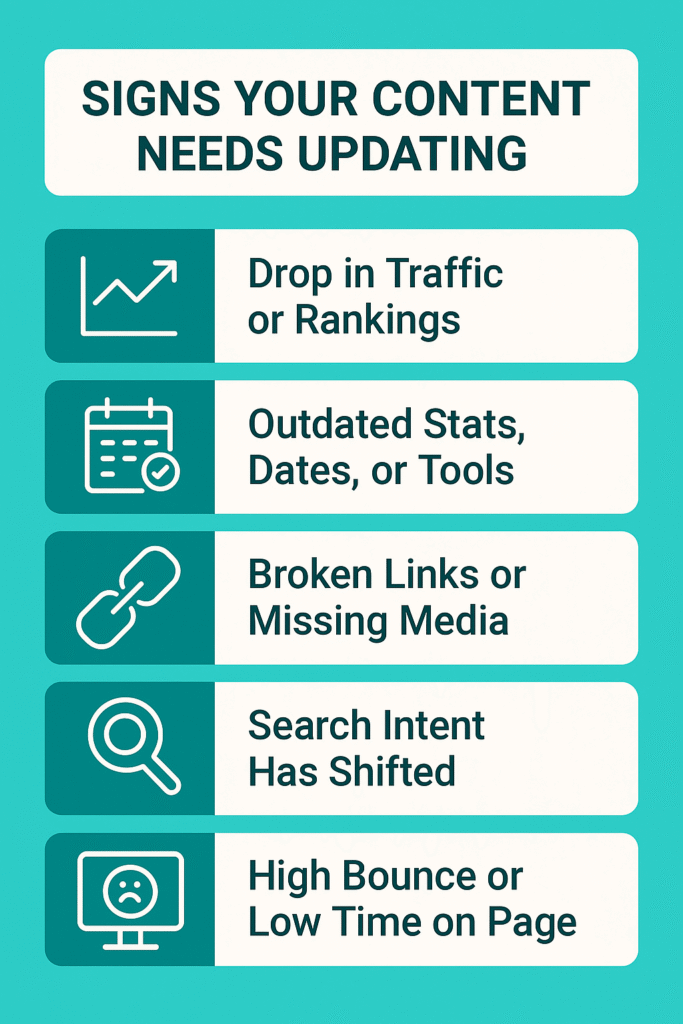
How to Properly Refresh Existing Content
Refreshing content is like giving your old pages a tune-up. It doesn’t mean you need to start from scratch. You just need to make them better. This will help you rank better, keep users happy, and show Google that your site is active.
First, you can start by checking which pages need work. Look for old blog posts, pages with falling traffic, or anything with outdated info. It would be wise to utilize tools like Google Search Console, Ahrefs, or Semrush to help you spot these pages fast.
Then ask, you should ask the following questions:
- Does this content still answer what people search for?
- Is it easy to read and helpful?
- Can it do more?
Once you have picked the page that needs some refreshing, go through the list below:
Element to Review | What to Do | Why It Matters |
Title and Meta Description | Rewrite to include fresh keywords and stronger hooks | Improves CTR and matches updated search intent |
Headers (H1–H3) | Reorganize or rephrase to include better structure and keywords | Helps readers and search engines understand the page better |
Outdated Stats and Dates | Replace with recent data and updated examples | Builds trust and keeps content current |
Broken or Old Links | Fix or replace with working, high-quality sources | Keeps users on-site and improves SEO quality |
Internal Linking | Add links to newer or related posts/pages | Boosts crawlability and helps other content rank |
Images and Visuals | Swap low-res or irrelevant images with fresh, helpful visuals | Makes content more engaging and readable |
CTAs (Call-to-Action) | Add or upgrade your CTA to reflect current offers or goals | Guides users toward the next step (signup, demo, read more) |
Keyword Optimization | Update keyword usage to match new trends and current search phrases | Aligns content with what users are searching today |
Content Format | Break up long blocks, add bullet points, improve spacing | Keeps bounce rate low and reading time high |
Page Speed & Mobile UX | Test load times and fix mobile display issues | Fast, clean experiences lower bounce rate and boost engagement |
Once you are done, update the “last modified” date. Google sees this as a freshness signal. Don’t forget to monitor the results. Track rankings, bounce rate, and clicks. A strong update doesn’t just look better – it brings better SEO results too.
Real Results From Updating Content: aboveA Case Studies
At aboveA, we’ve helped many businesses grow simply by updating the content they already had. These weren’t massive rewrites or redesigns – just smart, targeted improvements. Here are two real examples that show how powerful a refresh can be.
Logistics Company’s Landing Page Update Boosts Organic Traffic by 92%
A B2C logistics client, Viva Containers, had a landing page titled “Shipping Containers in Texas” that was written in 2022. It ranked on page 3 for its main keyword and had only 130 visits/month. We audited the page and saw several issues: outdated examples, broken links, zero internal links, and no clear CTA.
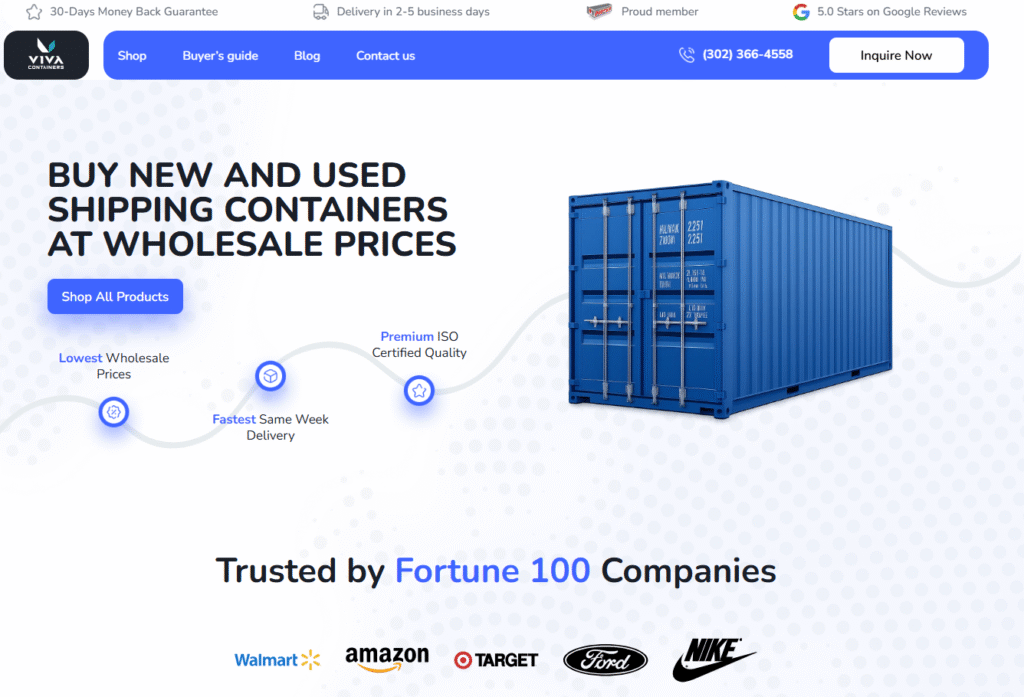
Regularly watching for these signs helps you catch weak points early and turn outdated pages into high performers again.
What we did:
- Updated statistics and user examples
- Added internal links to 4 newer articles
- Optimized the intro for featured snippet intent
- Added a visual walkthrough and downloadable template
- Changed the CTA from “learn more” to “download your shipping container kit.”
Results (60 days post-update):
- Organic traffic jumped from 130 to 250+ visits/month
- Ranked on page 1 (position #6)
- Time on page increased by 38%
- Three to Five new leads captured per week via the updated CTA
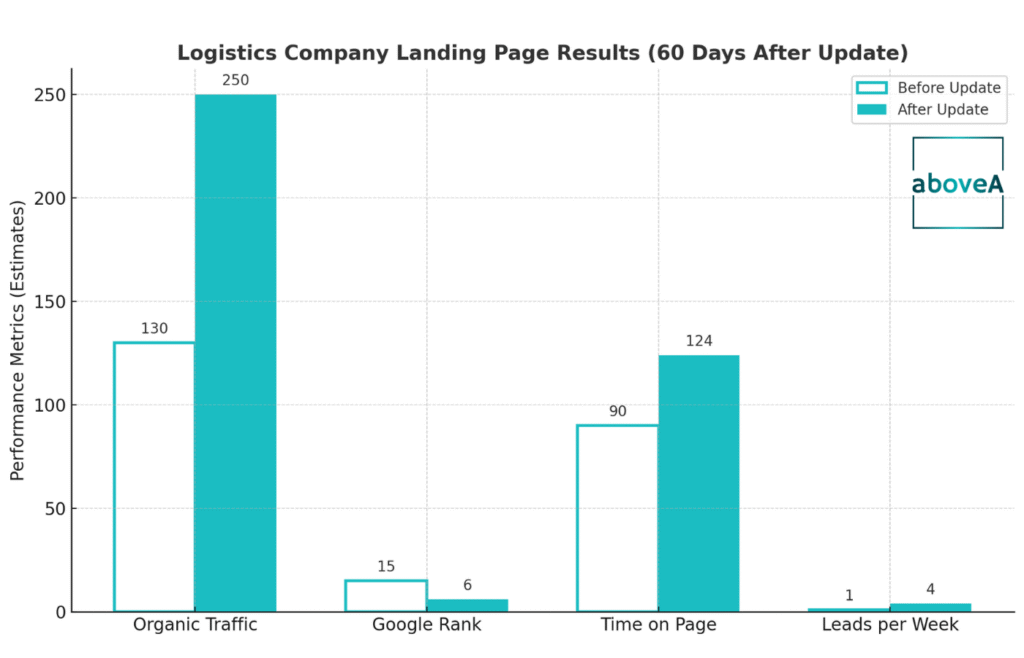
Recruitment Service Page for DACH Region: Refresh Cuts Bounce Rate by 41%
A client in the recruitment industry, TechBiz Global, had a service landing page that was attracting paid and organic traffic, but users weren’t sticking. Bounce rate was 78%. The conversion rate was below 1%.

Problems we identified:
- Weak above-the-fold content
- No clear trust signals or social proof
- CTA button looked passive (“Contact Us”)
- No internal links or structured layout
What we did:
- Rewrote the headline and added a subheadline with benefit-focused copy
- Included a short client testimonial and trust badge logos
- Replaced CTA with “Book a Free Logistics Assessment”
- Added internal links to pricing and case studies
Results (30 days post-refresh):
- Bounce rate dropped to 46%
- Average time on page increased by 52 seconds
- Conversion rate jumped from 0.9% to 3.4%
- ROI from paid traffic doubled
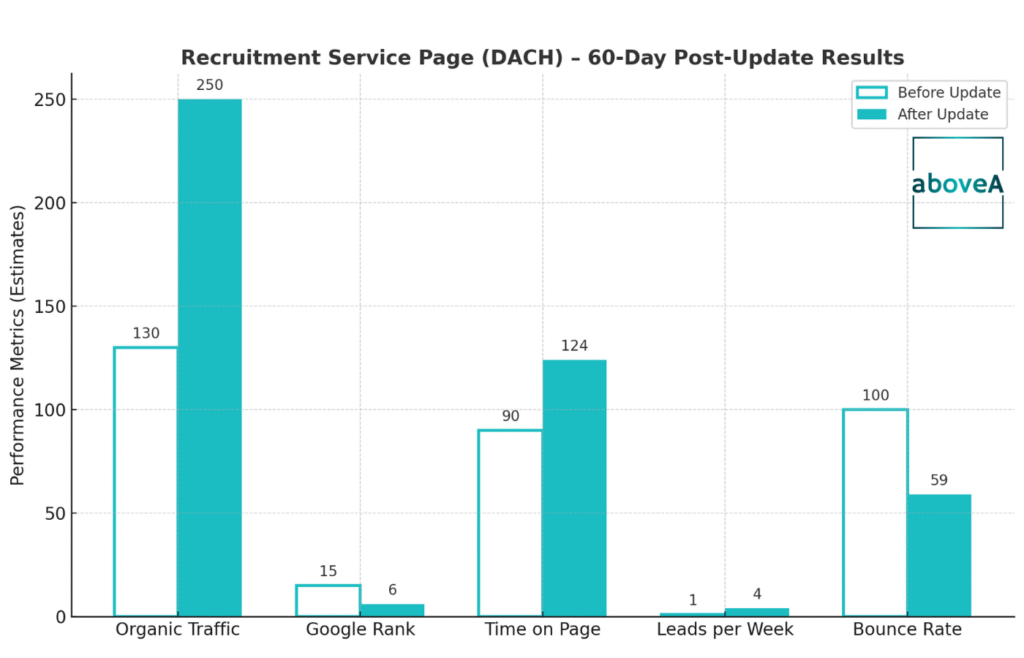
These content updates didn’t require months of work – just a clear process and thoughtful execution. At aboveA, we believe you don’t always need more content. You need better content. And sometimes, the best place to start is with what you’ve already got.
Old Content, New Results!
Your top pages might just need a refresh. We’ll find and fix what’s holding you back.
Recommended Content Update Schedule
If you want your website to stay fresh, relevant, and visible in search results, you need a clear plan. Not all pages need weekly edits, but they do need regular check-ins. A structured content marketing refresh plan ensures you focus on the right pages at the right time, without wasting effort.
Here’s a simple, effective web content optimization schedule you can follow:
Monthly | Quarterly | Annually |
Top 10 blog posts | Product and service pages | Evergreen guides and tutorials |
Trending or seasonal topics | Landing pages | Legal/disclaimer or compliance pages |
Low-traffic blog articles | Internal link audits | About/team/culture pages |
Review recently published posts | SEO keyword updates & checks | Long-form content + pillar articles |
Check CTAs on high-traffic pages | Fix broken links and redirects | Design updates or reformatting |
Helpful Tools and Tips
- Use Google Search Console to spot top and underperforming pages
- Use Ahrefs or Semrush to find decaying content or keyword gaps
- Run a full crawl with Screaming Frog to catch broken links and SEO issues
- Set calendar reminders or automate review cycles in your project management tool
- Consider doing a full quarterly SEO audit to catch structural or technical issues
While updating content regularly, one of the smartest ways to improve rankings is without writing new posts all the time. In that way, you will keep your SEO content maintenance on track, your visitors happy, and your business growing. A clean, consistent website content audit frequency is what separates top-performing sites from the rest.
When NOT to Update Content
Not all content needs refreshing. In fact, sometimes it’s smarter to leave things alone. If one of your pages is already ranking #1, bringing in stable traffic, and meeting search intent, then updating it could do more harm than good. Google already sees it as valuable. Don’t fix what isn’t broken.
Some evergreen answers, like basic definitions or how-to guides, don’t change often. If the advice is still accurate and users are engaging with the page, no need to tweak it just for the sake of activity. Also, you should avoid updating when you have nothing valuable to add. Changing a few words or dates without meaningful improvements will confuse Google or even hurt your rankings.
One rule to follow: only update when it benefits the user. If your content is clean, current, and performing well, the best move is to maintain high-ranking articles and focus your efforts on weaker spots. Choose updates with a purpose.
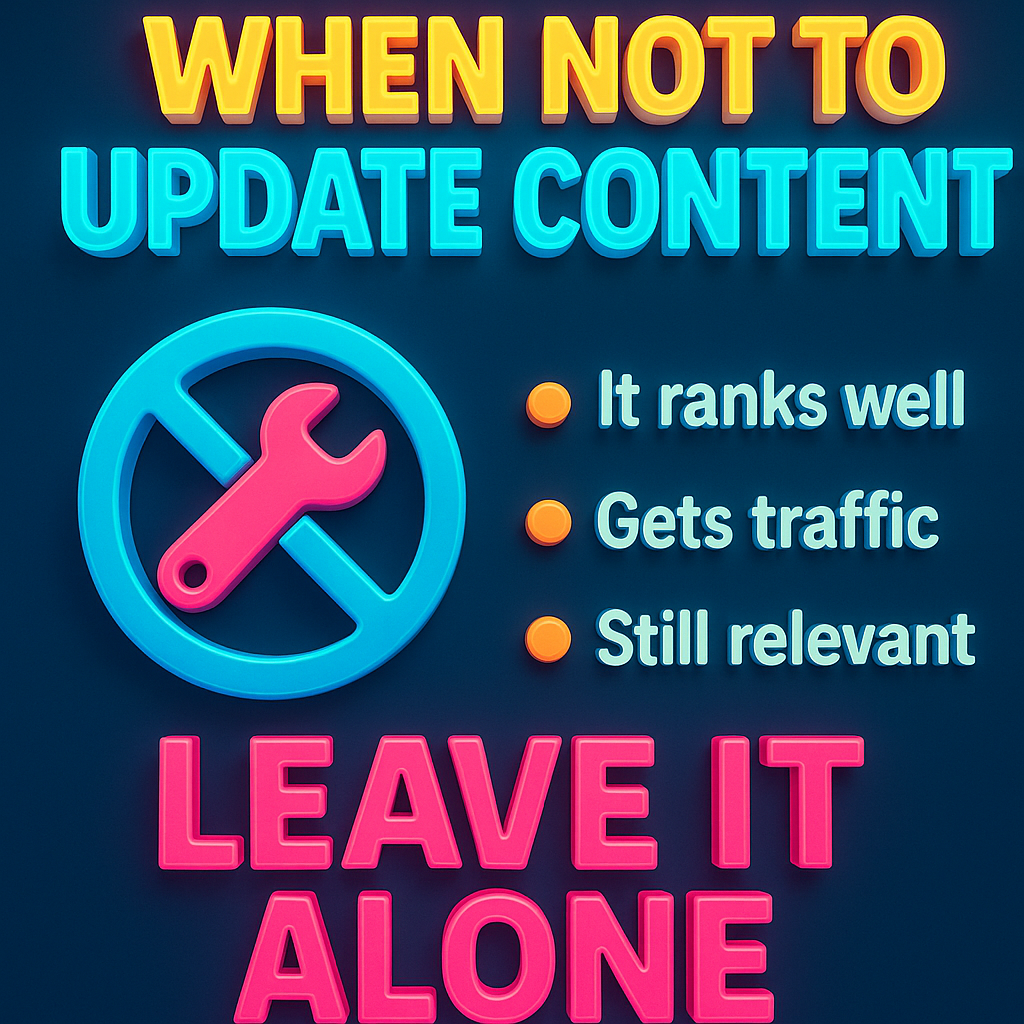
Conclusion: Keep It Fresh, But Be Smart
Regular content updates are one of the most powerful ways to stay visible, relevant, and competitive online. Whether it’s fixing outdated stats, improving structure, or matching new search intent, fresh content keeps users engaged and search engines interested. But remember, it’s not just about frequency; it’s about purpose.
In this guide, you learned how often to update website content, what to prioritize, and when to leave high-performing pages alone. With a clear plan, simple tools, and a little consistency, you can turn old pages into top performers without creating new content from scratch.
Meet the Author

Karina Kavaleuskaya
She combines a passion for storytelling with a strategic mindset to help brands grow, stand out, and connect deeply with their audiences. Through thoughtful, impactful writing, she turns complex ideas into clear, engaging narratives that drive results.

